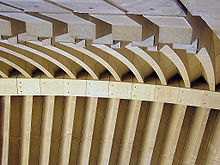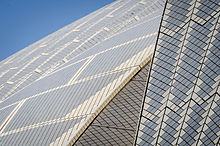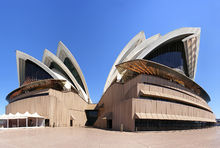#17. Sydney Opera House
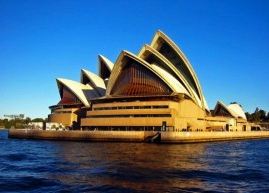
The Opera House Project: Story of an Australian Icon
The Sydney Opera House Project is an exploration of the history of Australia’s most famous structure, including how it was designed, constructed and altered throughout its life. We spoke to Sam Doust, Writer and Director of the Sydney Opera House Project about this epic project that employed a variety of old media and new technology including photos and film , recorded oral histories, and a 3D reconstruction that explores the inside and outside of the building; to tell this magnificent story.
Sydney Opera House Location: Sydney, Australia Architect: Jørn Utzon Year: 1973
Easily one of the most recognizable buildings in the world, the Sydney Opera House dominates the Australian city’s harbor. Architect Jørn Utzon, a Dane, is only the second person to have a building designated a World Heritage Site during their lifetime (this also means the building is recognized as a “masterpiece of human creative genius”).
The Sydney Opera House is a multi-venue performing arts centre in Sydney,New South Wales, Australia. Situated on Bennelong Point in Sydney Harbour, close to the Sydney Harbour Bridge, the facility is adjacent to the Sydney central business district and the Royal Botanic Gardens, between Sydney and Farm Coves. Designed by Danish architect Jørn Utzon, the facility formally opened on 20 October 1973 after a gestation beginning with Utzon’s 1957 selection as winner of an international design competition. The NSW Government, led by PremierJoseph Cahill authorised work to begin in 1958, with Utzon directing construction. The government’s decision to build Utzon’s design is often overshadowed by circumstances that followed, including cost and scheduling overruns as well as the architect’s ultimate resignation. Though its name suggests a single venue, the project comprises multiple performance venues which together are among the busiest performing arts centres in the world — hosting over 1,500 performances each year attended by some 1.2 million people. The venues produce and present a wide range of in-house productions and accommodate numerous performing arts companies, including four key resident companies: Opera Australia, The Australian Ballet, theSydney Theatre Company and the Sydney Symphony Orchestra. As one of the most popular visitor attractions in Australia, more than seven million people visit the site each year, with 300,000 people participating annually in a guided tour of the facility. Identified as one of the 20th century’s most distinctive buildings and one of the most famous performing arts centres in the world, the facility is managed by the Sydney Opera House Trust, under the auspices of the New South Wales Ministry of the Arts. The Sydney Opera House became a UNESCO World Heritage Site on 28 June 2007.
Description
The facility features a modern expressionist design, with a series of large precast concrete “shells,” each composed of sections of a sphere of 75.2 metres (246 ft 8.6 in) radius, forming the roofs of the structure, set on a monumental podium. The building covers 1.8 hectares (4.4 acres) of land and is 183 m (600 ft) long and 120 m (394 ft) wide at its widest point. It is supported on 588 concrete piers sunk as much as 25 m (82 ft) below sea level. Although the roof structures are commonly referred to as “shells” (as in this article), they are precast concrete panels supported by precast concrete ribs, not shells in a strictly structural sense. Though the shells appear uniformly white from a distance, they actually feature a subtle chevron pattern composed of 1,056,006 tiles in two colours: glossy white as well as matte cream. The tiles were manufactured by the Swedish company, Höganäs AB, which generally produced stoneware tiles for the paper-mill industry.
Apart from the tile of the shells and the glass curtain walls of the foyer spaces, the building’s exterior is largely clad with aggregate panels composed of pink granite quarried at Tarana. Significant interior surface treatments also include off-form concrete, Australian white birch plywood supplied from Wauchope in northern New South Wales, and brush box glulam. Of the two larger spaces, the Concert Hall is in the western group of shells, the Joan Sutherland Theatre in the eastern group. The scale of the shells was chosen to reflect the internal height requirements, with low entrance spaces, rising over the seating areas up to the high stage towers. The smaller venues (the Drama Theatre, the Playhouse, and The Studio) are within the podium, beneath the Concert Hall. A smaller group of shells set to the western side of the Monumental Steps houses the Bennelong Restaurant. The podium is surrounded by substantial open public spaces, and the large stone-paved forecourt area with the adjacent monumental steps is regularly used as a performance space.
Performance venues and facilities
It houses the following performance venues:
- The Concert Hall, with 2,679 seats, the home of the Sydney Symphony Orchestra and used by a large number of other concert presenters. It contains the Sydney Opera House Grand Organ, the largest mechanical tracker action organ in the world, with over 10,000 pipes.
- The Joan Sutherland Theatre, a proscenium theatre with 1,507 seats, the Sydney home of Opera Australia and The Australian Ballet. Until 16 October 2012 it was known as the Opera Theatre.
- The Drama Theatre, a proscenium theatre with 544 seats, used by the Sydney Theatre Company and other dance and theatrical presenters.
- The Playhouse, an end-stage theatre with 398 seats.
- The Studio, a flexible space with a maximum capacity of 400, depending on configuration.
- The Utzon Room, a small multi-purpose venue, seating up to 210.
- The Forecourt, a flexible open-air venue with a wide range of configuration options, including the possibility of utilising the Monumental Steps as audience seating, used for a range of community events and major outdoor performances. The Forecourt will be closed to visitors and performances in 2011–2014 to construct a new entrance tunnel to a rebuilt loading dock for the Joan Sutherland Theatre.
Other areas (for example the northern and western foyers) are also used for performances on an occasional basis. Venues are also used for conferences, ceremonies and social functions.
Other Facilities
The building also houses a recording studio, cafes, restaurants and bars and retail outlets. Guided tours are available, including a frequent tour of the front-of-house spaces, and a daily backstage tour that takes visitors backstage to see areas normally reserved for performers and crew members.
Construction History – Origins 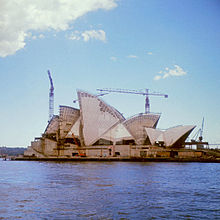 Construction progress in 1966
Construction progress in 1966
Planning began in the late 1940s, when Eugene Goossens, the Director of the NSW State Conservatorium of Music, lobbied for a suitable venue for large theatrical productions. The normal venue for such productions, the Sydney Town Hall, was not considered large enough. By 1954, Goossens succeeded in gaining the support of NSW Premier Joseph Cahill, who called for designs for a dedicated opera house. It was also Goossens who insisted that Bennelong Point be the site: Cahill had wanted it to be on or near Wynyard Railway Station in the northwest of the CBD. A design competition was launched by Cahill on 13 September 1955 and received 233 entries, representing architects from 32 countries. The criteria specified a large hall seating 3,000 and a small hall for 1,200 people, each to be designed for different uses, including full-scale operas, orchestral and choral concerts, mass meetings, lectures, ballet performances and other presentations. The winner, announced in 1957, was Jørn Utzon, a Danish architect. According to legend the Utzon design was rescued from a final cut of 30 “rejects” by the noted Finnish architect Eero Saarinen. The prize was £5,000. Utzon visited Sydney in 1957 to help supervise the project. His office moved to Sydney in February 1963. Utzon received the Pritzker Prize, architecture’s highest honour, in 2003. The Pritzker Prize citation read:
“There is no doubt that the Sydney Opera House is his masterpiece. It is one of the great iconic buildings of the 20th century, an image of great beauty that has become known throughout the world – a symbol for not only a city, but a whole country and continent.”
Design and Construction
The Fort Macquarie Tram Depot, occupying the site at the time of these plans, was demolished in 1958 and construction began in March 1959. It was built in three stages: stage I (1959–1963) consisted of building the upper podium; stage II (1963–1967) the construction of the outer shells; stage III (1967–1973) interior design and construction.
Stage I: Podium
Stage I commenced on 2 March 1959 with the construction firm Civil & Civic, monitored by the engineers Ove Arup and Partners. The government had pushed for work to begin early, fearing that funding, or public opinion, might turn against them. However, Utzon had still not completed the final designs. Major structural issues still remained unresolved. By 23 January 1961, work was running 47 weeks behind, mainly because of unexpected difficulties (inclement weather, unexpected difficulty diverting stormwater, construction beginning before proper construction drawings had been prepared, changes of original contract documents). Work on the podium was finally completed in February 1963. The forced early start led to significant later problems, not least of which was the fact that the podium columns were not strong enough to support the roof structure, and had to be re-built.
Stage II: Roof 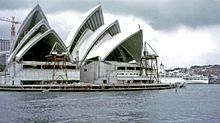 Construction progress in 1968
Construction progress in 1968
The shells of the competition entry were originally of undefined geometry, but, early in the design process, the “shells” were perceived as a series of parabolas supported byprecast concrete ribs. However, engineers Ove Arup and Partners were unable to find an acceptable solution to constructing them. The formwork for using in-situ concrete would have been prohibitively expensive, but, because there was no repetition in any of the roof forms, the construction of precast concrete for each individual section would possibly have been even more expensive. From 1957 to 1963, the design team went through at least 12 iterations of the form of the shells trying to find an economically acceptable form (including schemes with parabolas, circular ribs and ellipsoids) before a workable solution was completed. The design work on the shells involved one of the earliest uses of computers in structural analysis, to understand the complex forces to which the shells would be subjected. In mid-1961, the design team found a solution to the problem: the shells all being created as sections from a sphere. This solution allows arches of varying length to be cast in a common mould, and a number of arch segments of common length to be placed adjacent to one another, to form a spherical section. With whom exactly this solution originated has been the subject of some controversy. It was originally credited to Utzon. Ove Arup’s letter to Ashworth, a member of the Sydney Opera House Executive Committee, states: “Utzon came up with an idea of making all the shells of uniform curvature throughout in both directions.” Peter Jones, the author of Ove Arup’s biography, states that “the architect and his supporters alike claimed to recall the precise eureka moment … ; the engineers and some of their associates, with equal conviction, recall discussion in both central London and at Ove’s house.” He goes on to claim that “the existing evidence shows that Arup’s canvassed several possibilities for the geometry of the shells, from parabolas to ellipsoids and spheres.” Yuzo Mikami, a member of the design team, presents an opposite view in his book on the project, Utzon’s Sphere. It is unlikely that the truth will ever be categorically known, but there is a clear consensus that the design team worked very well indeed for the first part of the project and that Utzon, Arup, and Ronald Jenkins (partner of Ove Arup and Partners responsible for the Opera House project) all played a very significant part in the design development. As Peter Murray states in The Saga of the Sydney Opera House:
“… the two men—and their teams—enjoyed a collaboration that was remarkable in its fruitfulness and, despite many traumas, was seen by most of those involved in the project as a high point of architect/engineer collaboration.”
The shells were constructed by Hornibrook Group Pty Ltd, who were also responsible for construction in Stage III. Hornibrook manufactured the 2400 precast ribs and 4000 roof panels in an on-site factory and also developed the construction processes. The achievement of this solution avoided the need for expensive formwork construction by allowing the use of precast units (it also allowed the roof tiles to be prefabricated in sheets on the ground, instead of being stuck on individually at height). Ove Arup and Partners’ site engineer supervised the construction of the shells, which used an innovative adjustable steel-trussed “erection arch” to support the different roofs before completion. On 6 April 1962, it was estimated that the Opera House would be completed between August 1964 and March 1965.
Stage III: Interiors 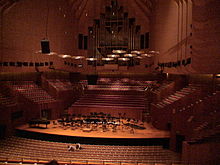 The Concert Hall and organ
The Concert Hall and organ
Stage III, the interiors, started with Utzon moving his entire office to Sydney in February 1963. However, there was a change of government in 1965, and the new Robert Askin government declared the project under the jurisdiction of the Ministry of Public Works. This ultimately led to Utzon’s resignation in 1966 (see below). The cost of the project so far, even in October 1966, was still only $22.9 million, less than a quarter of the final $102 million cost. However, the projected costs for the design were at this stage much more significant. The second stage of construction was progressing toward completion when Utzon resigned. His position was principally taken over by Peter Hall, who became largely responsible for the interior design. Other persons appointed that same year to replace Utzon were E. H. Farmer as government architect, D. S. Littlemore and Lionel Todd. Following Utzon’s resignation, the acoustic advisor, Lothar Cremer, confirmed to the Sydney Opera House Executive Committee (SOHEC) that Utzon’s original acoustic design allowed for only 2000 seats in the main hall and further stated that increasing the number of seats to 3000 as specified in the brief would be disastrous for the acoustics. According to Peter Jones, the stage designer, Martin Carr, criticised the “shape, height and width of the stage, the physical facilities for artists, the location of the dressing rooms, the widths of doors and lifts, and the location of lighting switchboards.”
Significant changes to Utzon’s design 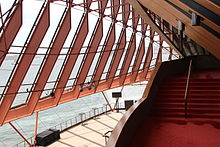 The foyer of the Joan Sutherland Theatre, showing the internal structure and steel framing of the glass curtain walls; the final constructions were modified from Utzon’s original designs
The foyer of the Joan Sutherland Theatre, showing the internal structure and steel framing of the glass curtain walls; the final constructions were modified from Utzon’s original designs

View of the Opera House from the Harbour Bridge.
- The major hall, which was originally to be a multipurpose opera/concert hall, became solely a concert hall, called the Concert Hall. The minor hall, originally for stage productions only, incorporated opera and ballet functions and was called the Opera Theatre, later renamed the Joan Sutherland Theatre. As a result, the Joan Sutherland Theatre is inadequate to stage large-scale opera and ballet. A theatre, a cinema and a library were also added. These were later changed to two live drama theatres and a smaller theatre “in the round”. These now comprise the Drama Theatre, the Playhouse, and the Studio, respectively. These changes were primarily because of inadequacies in the original competition brief, which did not make it adequately clear how the Opera House was to be used. The layout of the interiors was changed, and the stage machinery, already designed and fitted inside the major hall, was pulled out and largely thrown away.
- Externally, the cladding to the podium and the paving (the podium was originally not to be clad down to the water, but to be left open).
- The construction of the glass walls (Utzon was planning to use a system of prefabricated plywood mullions, but a different system was designed to deal with the glass).
- Utzon’s plywood corridor designs, and his acoustic and seating designs for the interior of both major halls, were scrapped completely. His design for the Concert Hall was rejected as it only seated 2000, which was considered insufficient. Utzon employed the acoustic consultant Lothar Cremer, and his designs for the major halls were later modelled and found to be very good. The subsequent Todd, Hall and Littlemore versions of both major halls have some problems with acoustics, particularly for the performing musicians. The orchestra pit in the Joan Sutherland Theatre is cramped and dangerous to musicians’ hearing. The Concert Hall has a very high roof, leading to a lack of early reflections onstage—perspex rings (the “acoustic clouds”) hanging over the stage were added shortly before opening in an (unsuccessful) attempt to address this problem.
Completion and cost
The Opera House was formally completed in 1973, having cost $102 million. H.R. “Sam” Hoare, the Hornibrook director in charge of the project, provided the following approximations in 1973: Stage I: podium Civil & Civic Pty Ltd approximately $5.5m. Stage II: roof shells M.R. Hornibrook (NSW) Pty Ltd approximately $12.5m. Stage III: completion The Hornibrook Group $56.5m. Separate contracts: stage equipment, stage lighting and organ $9.0m. Fees and other costs: $16.5m. The original cost and scheduling estimates in 1957 projected a cost of £3,500,000 ($7 million) and completion date of 26 January 1963 (Australia Day). In actuality, the project was completed ten years late and more than fourteen times over budget.
Jørn Utzon and his resignation

At night
Before the Sydney Opera House competition, Jørn Utzon had won seven of the 18 competitions he had entered but had never seen any of his designs built. Utzon’s submitted concept for the Sydney Opera House was almost universally admired and considered groundbreaking. The Assessors Report of January 1957, stated:
“The drawings submitted for this scheme are simple to the point of being diagrammatic. Nevertheless, as we have returned again and again to the study of these drawings, we are convinced that they present a concept of an Opera House which is capable of becoming one of the great buildings of the world.”
For the first stage, Utzon worked very successfully with the rest of the design team and the client, but, as the project progressed, the Cahill government insisted on progressive revisions. They also did not fully appreciate the costs or work involved in design and construction. Tensions between the client and the design team grew further when an early start to construction was demanded despite an incomplete design. This resulted in a continuing series of delays and setbacks while various technical engineering issues were being refined. The building was unique, and the problems with the design issues and cost increases were exacerbated by commencement of work before the completion of the final plans. After the election of Robert Askin as Premier of New South Wales in 1965, the relationship of client, architect, engineers and contractors became increasingly tense. Askin had been a “vocal critic of the project prior to gaining office.” His new Minister for Public Works, Davis Hughes, was even less sympathetic. Elizabeth Farrelly, Australian architecture critic, has written that:
“at an election night dinner party in Mosman, Hughes’s daughter Sue Burgoyne boasted that her father would soon sack Utzon. Hughes had no interest in art, architecture or aesthetics. A fraud, as well as a philistine, he had been exposed before Parliament and dumped as Country Party leader for 19 years of falsely claiming a university degree. The Opera House gave Hughes a second chance. For him, as for Utzon, it was all about control; about the triumph of homegrown mediocrity over foreign genius.”
Differences ensued. One of the first was that Utzon believed the clients should receive information on all aspects of the design and construction through his practice, while the clients wanted a system (notably drawn in sketch form by Davis Hughes) where architect, contractors, and engineers each reported to the client directly and separately. This had great implications for procurement methods and cost control, with Utzon wishing to negotiate contracts with chosen suppliers (such as Ralph Symonds for the plywood interiors) and the New South Wales government insisting contracts be put out to tender.
Utzon was highly reluctant to respond to questions or criticism from the client’s Sydney Opera House Executive Committee (SOHEC). However, he was greatly supported throughout by a member of the committee and one of the original competition judges, Professor Harry Ingham Ashworth. Utzon was unwilling to compromise on some aspects of his designs that the clients wanted to change. Utzon’s ability was never in doubt, despite questions raised by Davis Hughes, who attempted to portray Utzon as an impractical dreamer. Ove Arup actually stated that Utzon was “probably the best of any I have come across in my long experience of working with architects” and: “The Opera House could become the world’s foremost contemporary masterpiece if Utzon is given his head.”


